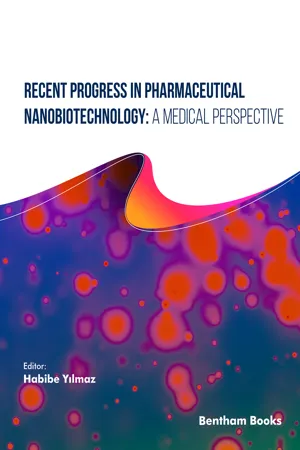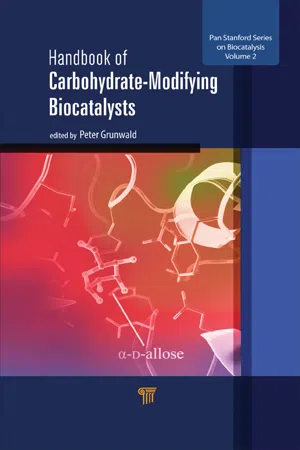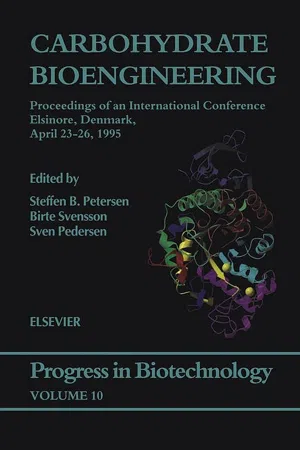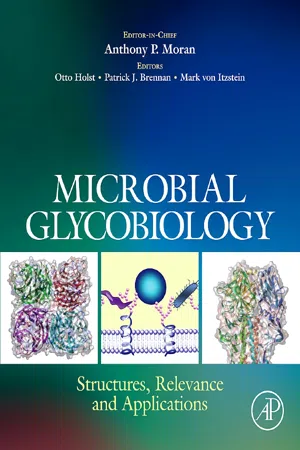Biological Sciences
Glycocalyx
Glycocalyx is a layer of carbohydrates that coats the surface of cells. It plays a crucial role in cell recognition, adhesion, and protection. The glycocalyx is involved in various biological processes, including immune response, cell signaling, and pathogen recognition.
Written by Perlego with AI-assistance
Related key terms
1 of 4
Related key terms
1 of 3
8 Key excerpts on "Glycocalyx"
- eBook - ePub
Mechanobiology
Exploitation for Medical Benefit
- Simon C. F. Rawlinson(Author)
- 2017(Publication Date)
- Wiley-Blackwell(Publisher)
3 Sugar‐Coating the Cell : The Role of the Glycocalyx in MechanobiologyStefania Marcotti and Gwendolen C. ReillyDepartment of Materials Science and Engineering, INSIGNEO Institute for In Silico Medicine, Sheffield, UK3.1 What is the Glycocalyx?
The cell coat or Glycocalyx is a proteoglycan‐rich layer on the external surface of the cell membrane. Its thickness and proteoglycan composition vary according to the cell type and function. Glycocalyx means “sugar cup,” and as well as long proteoglycan chains, it consists of small glycoproteins and glycosylated proteins, such that it contains a dense layer of glycosaminoglycan (GAG) chains (Tarbell and Pahakis 2006). This layer is also known as the pericellular matrix (PCM), though that term is more commonly used for the thick proteoglycan layer around chondrocytes forming the chondron, to distinguish it from the extracellular matrix (ECM), which forms the bulk cartilage. The terms “Glycocalyx” and “PCM” are often used interchangeably, but the chondrocyte PCM is particularly thick and is characterized by specific composition and features; it is reviewed in detail elsewhere (Guilak et al. 2006; Wilusz et al. 2014). In this chapter, we will not consider the chondrocyte PCM in detail, but will focus on the Glycocalyx of endothelial, bone, and muscle cells.The Glycocalyx components can be connected to the cell membrane via transmembrane proteoglycan‐binding proteins or can span through the phospholipidic double layer. Glycoproteins and proteoglycans have a strong negative charge and attract water, so the Glycocalyx is broadly very soft and water‐saturated. Its gel‐like characteristics modulate adhesion by providing resistance to certain protein–protein adhesions and enabling weak binding to specific molecules. To allow protein–protein binding, such as that between integrins and the ECM molecule fibronectin (Paszek et al. 2014), an energy barrier has to be overcome, with the proteoglycan molecules pushed aside or squashed to allow contact (Rutishauser et al. 1988; Soler et al. 1997, 1998; Sabri et al. 2000; Lipowsky 2012). - Habibe Yilmaz(Author)
- 2001(Publication Date)
- Bentham Science Publishers(Publisher)
In many studies using cationic dyes such as alcian blue and ruthenium red, it has been shown that almost all cells are surrounded by Glycocalyx, known as carbohydrate sheath [ 6, 9 ]. Oligosaccharides and polysaccharides that are linked to proteins or lipids in the membrane make up Glycocalyx. Even though erythrocytes are small eukaryotic cells, they feature a relatively extensive and complicated Glycocalyx [ 10, 11 ]. This structure, which is present in all cells, consists of several glycoconjugates, which are quite complex. This structure is critical to cell biology as it specifically mediates and modulates interactions of the cell with small molecules, macromolecules, the extracellular matrix, and other cells. From this point of view, the Glycocalyx is much more complex and selective in terms of its molecular interactions, although it has the physical properties of both ion exchange resins and gel filtration. In addition to serving as recognition molecules in multicellular interactions, saccharides of Glycocalyx linked to proteins and lipids also act as binding sites for bacterial and viral pathogens [ 12, 13 ]. Laminin, collagen, and fibronectin, among other secreted glycoproteins, fill the gaps between eukaryotic cells. Additionally, proteoglycans and glycosaminoglycans contribute substantially to the extracellular matrix's structure. For instance, the three different types of corneal cells secrete proteoglycans and collagens that are highly ordered to preserve the tissue's uniqueness [ 14 - 18 ]. Likewise, the flexibility of cartilage is largely provided by the large amount of highly negatively charged proteoglycans and collagen synthesized by chondrocytes [ 19 - 22 ]. Extracellular matrix glycoconjugates play an important role not only in development and cellular interaction, but also in determining the physical properties of the matrix [ 14, 16, 18, 23 ]- eBook - ePub
- Peter Grunwald(Author)
- 2016(Publication Date)
- Jenny Stanford Publishing(Publisher)
Chapter 3
Oligosaccharides and Glycoconjugates in Recognition Processes
Thisbe K. Lindhorst Otto Diels Institute of Organic Chemistry, Christiana Albertina University of Kiel,Otto-Hahn-Platz 3/4, D -24098 Kiel, Germany[email protected]3.1 Introduction
All cells, eukaryotic cells in a special way, are covered with carbohydrates of enormous diversity. These are part of different glycoconjugates, which are embedded into the lipid bilayer of the plasma membrane or associated to the Glycocalyx of the cell. The Glycocalyx is a highly complex sugar coating, which is typical for every eukaryotic cell and indispensable for living organisms. It can be considered to form an interconnecting supramolecular entity between the extracellular matrix and the cytoskeleton and, apparently, is an indispensable cell compartment.Saccharides are major constituents of the Glycocalyx, playing an essential role in cell biology. This is well known for the famous blood group antigens of red blood cells, all of them being carbohydrates.Handbook of Carbohydrate-Modifying Biocatalysts Edited by Peter Grunwald Copyright © 2016 Pan Stanford Publishing Pte. Ltd. ISBN 978-981-4669-78-8 (Hardcover), 978-981-4669-79-5 (eBook) www.panstanford.comThe biological significance of cell surface carbohydrates in cell communication unfolds in a highly complex interplay with one another and other molecules, both membrane-anchored receptors and soluble proteins. Such secreted or membrane-bound proteins, which can recognize carbohydrates to form carbohydrate- protein complexes, are called lectins. They occur ubiquitously in all organisms and are involved in cell development, the immune system, signal transduction, and also states of disease and malignancy. Intracellular lectins often recognize core structures from glycoconjugate oligosaccharides, while cell surface and extracellular lectins frequently bind to terminal carbohydrate residues. The diversity of lectins, the molecular details of their interaction with glycans, the predominant multivalency effects occurring in carbohydrate–lectin interactions and the biological significance of carbohydrate-protein complex formation, including bacterial adhesion and orientational effects, are subject of this chapter. - eBook - ePub
Glycome Informatics
Methods and Applications
- Kiyoko F. Aoki-Kinoshita(Author)
- 2009(Publication Date)
- Chapman and Hall/CRC(Publisher)
1 can serve as intermediates in generating energy and as signaling effectors, recognition markers, and structural components. Especially in cell-cell, cell-matrix, and cell-molecule interactions, carbohydrates are particularly important for complex multicellular organisms. Thus the understanding of how these molecules function may be a major key in understanding the genome and the biological processes of complex systems (Varki et al. (2008)).1.1Roles of carbohydrates
Glycans may be analogized to access card readers to cells by which proteins function as cards containing access codes. Glycans decorate the surface of cells either directly or on cell surface proteins such that other biomolecules such as viruses, bacteria, pathogens and other proteins may recognize the appropriate structures to bind to the target cells. The difficulty is that the glycans are flexible, and that depending on the environment, the structures of the glycans change. Using the analogy above, these access card readers may change their codes according to the temperature, humidity, or even time of day, for example. Thus proteins are allowed access only when the right conditions are met. In biological terms, the functions of many proteins are affected by glycan structure conformations which are governed by environmental conditions, thus emphasizing the importance of glycans and their functions on proteins.In general, there are two broad categories into which the biological roles of glycans may be divided: (1) the structural and modulatory properties of glycans and (2) the specific recognition of glycans by other molecules, which include glycan-binding proteins (GBPs). There are two types of GBPs: intrinsic and extrinsic; the former referring to those that recognize glycans within the same organism, and the latter referring to those that recognize glycans from a different organism. Intrinsic GBPs generally function to mediate cell-cell interactions or to recognize extracellular molecules; they may also recognize glycans on the same cell. In contrast, extrinsic GBPs include pathogenic microbes, toxins and molecules mediating symbiotic relationships. These contrary roles of glycan recognition are suggested to act as opposing selective forces, which consequently affect evolutionary changes in biological systems (Varki et al. (2008)). - eBook - ePub
Fundamentals of Biochemistry, Integrated E-Text with E-Student Companion
Life at the Molecular Level
- Donald Voet, Judith G. Voet, Charlotte W. Pratt(Authors)
- 2017(Publication Date)
- Wiley(Publisher)
FIG. 8-14 A Pseudomonas aeruginosa biofilm. Bacterial colonies growing on the surface of an agar plate form a biofilm with complex architecture.What chemical property of glycans allows them to retain moisture?The gel-like consistency of a biofilm—for example, the plaque that forms on teeth—prevents bacterial cells from being washed away and protects them from desiccation. Biofilms that develop on medical apparatus, such as catheters, are problematic because they offer a foothold for pathogenic organisms and create a barrier to soluble antimicrobial agents.CHECKPOINT
- Describe the monosaccharide units and their linkages in the common disaccharides and polysaccharides.
- Explain why the systematic name of an oligosaccharide must include more than just the names of the component monosaccharides.
- Compare and contrast the structures and functions of cellulose, chitin, starch, and glycogen.
- How do the physical properties of glycosaminoglycans and similar molecules relate to their biological roles?
3 Glycoproteins
KEY CONCEPTS
- Proteoglycans are large, glycosaminoglycan-containing proteins.
- Bacterial cell walls consist of glycan chains cross-linked by peptides.
- The oligosaccharide chains covalently attached to eukaryotic glycoproteins may play a role in protein structure and recognition.
Many proteins are actually glycoproteins, with carbohydrate contents varying from< 1 %to> 90 %by weight. Glycoproteins occur in all forms of life and have functions that span the entire spectrum of protein activities, including those of enzymes, transport proteins, receptors, hormones, and structural proteins. The polypeptide chains of glycoproteins, like those of all proteins, are synthesized under genetic control. Their carbohydrate chains, in contrast, are enzymatically generated and covalently linked to the polypeptide without the rigid guidance of nucleic acid templates. For this reason, glycoproteins tend to have variable carbohydrate composition, a phenomenon known asmicroheterogeneity. Characterizing the structures of carbohydrates—and their variations—is one goal of the field ofglycomics - eBook - ePub
- S.B. Petersen, B. Svensson, S. Pedersen(Authors)
- 1995(Publication Date)
- Elsevier Science(Publisher)
Glycans of glycoconjugates as modulatory and recognition molecules
Nathan Sharon Department of Membrane Research and Biophysics, The Weizmann Institute of Science, Rehovot 76100, IsraelAbstract
Glycoproteins and glycolipids are the most common classes of glycoconjugates. Their glycans are structurally diverse, although overlapping to some extent. The functions of these glycans are mostly unknown, but from the information available it is clear that they often modulate the physicochemical properties of the proteins to which they are attached, and sometimes also their biological activities. In addition, there is increasing evidence that many of these glycans, whether protein or lipid bound, serve as recognition determinants in molecule-cell and cell-cell interactions. The knowledge accrued is having a marked impact on the biotechnological production of therapeutically useful glycoproteins and provides a strong impetus for the development of novel types of drugs for a wide range of diseases, such as microbial infections, inflammation and cancer.1 INTRODUCTION
Living organisms produce a bewildering array of glycans, many of them in the form of glycoproteins or glycolipids. These generally go under the term glycoconjugates or complex carbohydrates. The question of the function of these glycans is currently attracting increasing interest. Thus, oligosaccharides attached to proteins often modulate the physicochemical and biological properties of the latter. Furthermore, changes in glycan structure accompany many normal and pathological processes, from differentiation and development to cancer. In some cases, specific carbohydrates on cancer cells have been correlated with the tumor grade, metastatic potential and prognosis, raising the possibility that glycans may serve as markers for diagnostic purposes and as targets for drugs. Developments in genetic engineering have made possible the biotechnological production of pharmaceutically useful glycoproteins, both for research purposes and for therapeutic use. Last, but not least, is the prospect of creating carbohydrate-based drugs for the treatment of many diseases, from microbial infections to cancer. - eBook - ePub
Glycoconjugate Research
Proceedings of the Interior Symposium on Glycoconjugates
- John Gregory(Author)
- 2012(Publication Date)
- Academic Press(Publisher)
Table I ).Table I Carbohydrate Receptors on Cell Surfaces for Substances Inducing a Biological Response in Target Cells and the Effects of Purified GlycosidasesSubstance bound Cell source of receptor Properties of receptor Ref. Insulin Liver, fat cells β-Galactosidase abolishes activity 4 ,5 Adrenocorticotrophic hormone Adrenal gland Neuraminidase abolishes activity 17 Antibodies Lymphocytes Inactivated by endo-β-N-acetylglucosaminidase 60 Lectins Most cells See text Macrophage inhibitory factor (MIF) Macrophages Fucose determinant 14 Macrophage stimulatory factor (MSF) Macrophages N-Acetylgalactosamine determinant 14 Asialoglycoproteins Liver Inactivated by neuraminidase 18 Tuftsin Po1ymorphonuclear cells Inactivated by neuraminidase 15 The purification of receptors for insulin or thyrotropin from the surface membranes of suitable target cells, for example, shows unequivocally that these are glycoproteins, which are integral membrane components and can be solubilized only after complete or almost complete dissolution of membranes, for example by mild non-ionic detergents (4 ,12 ). The thyrotropin-receptor complex also appears to contain ganglioside (12 ), which in some tissues is also the receptor for cholera toxin and interferon (10 ,13 ). In solution, many receptors retain considerable biological activity and specificity, and are therefore amenable to purification by affinity chromatography on columns containing the insolubilized ligand, e.g., hormone. The in situ response of several of these receptors to the appropriate effector is diminished by specific glycosidases. A preliminary report (4 ) indicated that while insulin binding to specific receptors is unaffected by neuraminidase treatment of liver or fat cells, thus showing that sialic acid groups are not involved in the binding site for hormone, subsequent treatment with β-galactosidase rapidly inactivated the receptor activity so that β-galactosyl groups appear to be important in hormone recognition. Particularly interesting examples involve substances that activate or immobilize macrophages (14 ). These appear to require expression of N- acetylgalactosamine and fucose residues at the macrophage surface (Table I ). Tuftsin (Table I ) is a tetra-peptide, L-threonyl-L-lysyl-L-prolyl-L-arginine, derived from cytophilic antibody by proteolysis; it binds to polymorphonuclear leukocytes and stimulates in some unknown way their phagocytic activity. The response of the phagocytes is abolished by removal of sialic acid (15 - eBook - ePub
Microbial Glycobiology
Structures, Relevance and Applications
- Anthony P Moran, Otto Holst, Patrick Brennan, Mark von Itzstein(Authors)
- 2009(Publication Date)
- Academic Press(Publisher)
Chapter 7. Bacterial surface layer glycoproteins and “non-classical” secondary cell wall polymersPaul Messner, Eva Maria Egelseer, Uwe B. Sleytr and Christina Schäffer
Summary
Cell surface layers, S-layers, are common structures of the prokaryotic cell envelope with a lattice-like appearance. They are formed by a self-assembly process and are attached to the bacterial cell via a special class of secondary cell wall polymers. Frequently, the constituting S-layer proteins are modified with covalently linked glycan chains facing the extracellular environment. S-layer glycoproteins by far exceed the display found with eukaryal or viral glycoproteins, making them ideal targets for studying the molecular basis of bacterial protein glycosylation. While in the past, research was focused on the elucidation of S-layer glycan structures and on their biochemistry, now, a molecular picture of the S-layer glycosylation process is evolving. This is the basis for the envisaged combination of S-layers with heterologous glycosylation systems to produce functional S-layer neoglycoproteins that, according to their intrinsic property to self-assemble into crystalline arrays, allow controlled and oriented display of glycan motifs with nanometer-scale periodicity. Together with the developing understanding of the mode of interaction between S-layer (glyco)proteins and secondary cell wall polymers this will pave the way towards the production of novel nanopatterned “biomaterials” for various applications in the fields of biomedicine and nanobiotechnology, using carbohydrate recognition.Keywords: Cell wall component; Crystalline array; Glycoprotein; Molecular basis; Nano-biotechnology; Nanopatterning; Prokaryotic glycosylation; Secondary cell wall polymer; S-layer1. Introduction
A major issue for the survival of bacteria in a competitive habitat was the development of highly specific cell envelope structures as the primary site of interaction with the environment. These were even more diversified through incorporation and attachment of saccharide structures. This chapter focuses on unique, (glyco)protein self-assembly structures, forming two-dimensional crystalline arrays on bacterial cell surfaces (S-layers) (Sleytr and Beveridge, 1999 ;Sleytr et al., 2007) and on their cell wall-anchoring polysaccharides (Mesnage et al., 2000; Sára, 2001 ; Schäffer and Messner, 2005
Index pages curate the most relevant extracts from our library of academic textbooks. They’ve been created using an in-house natural language model (NLM), each adding context and meaning to key research topics.
Explore more topic indexes
Explore more topic indexes
1 of 6
Explore more topic indexes
1 of 4







